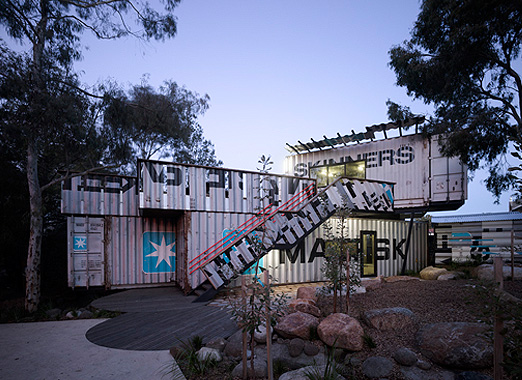The global trend for temporary, pop-up spaces is growing faster than ever. Architects and property owners are merging their creative talents to come up with temporary sites, occupying otherwise unused inner city spaces.
May 6th, 2008
indesignlive.com spoke with Orbit Solutions architects, Chris Goss and Darren Cole-Sinclair, about the trend.
“There is a trend for shipping container style-housing design and construction as it can offer residents a prefabricated and transportable shell within which a contemporary finish and interiors can be applied,” says Chris Goss.
“Container architecture is an environmental, affordable solution that can offer unique design and highly modernized functionality”.
Darren Cole-Sinclair also from Orbit Solutions says that “container architecture is all about recycling “useless” refuse into a finely built product”.
More and more designers are developing nomadic alternatives to traditional models of static urban living. According to Cole-Sinclair “container architecture has the capacity to completely re-shape the idea of a kit-home”.
In the past, containers have been used for temporary disaster relief as well as military housing, the trend for permanent container housing is primarily being built in California, however this phenomenon in architecture is starting to sweep the globe.
However this trend is not without it critics, according to W.A State Labor MP Shane Hill says it is “not Australian” to put people into the disused sea containers.
Goss would deign to disagree sighting the historic irony of such criticism. “Australia has millennia of built form created from accessible materials. The indigenous population has always been creatively utilizing those things at hand to create shelter.
“As a basic requirement for human survival shelter is one of the vital ingredients of home making. Throughout the relatively short period of European settlement making use of shipping elements and other ‘refuse’ has been a common recurring theme in vernacular style”.
“Shack ‘architecture’ is the epitome of the Aussie spirit,” Goss says. “My family have an old fishing shack on the shore of one of Tasmania’s great trout Lakes. That shack was built by my great grandfather and his brother out of tin tea chests."
Orbit Solutions
http://www.orbitsolutions.com.au/
Below: A children’s day care centre made from a shipping containers by Phooey Architects. Skinners Playground, Melbourne.

INDESIGN is on instagram
Follow @indesignlive
A searchable and comprehensive guide for specifying leading products and their suppliers
Keep up to date with the latest and greatest from our industry BFF's!

A longstanding partnership turns a historic city into a hub for emerging talent
The new range features slabs with warm, earthy palettes that lend a sense of organic luxury to every space.

The Nintendo game Animal Crossing has taken the world by storm and it turns out the interior designs that work in the real world have been a big help to people designing their ‘virtual spaces’.
Swanbury Penglase Architects celebrated 20 years of successful architecture, interior architecture, heritage and landscape architecture at the Majestic Roof Garden Hotel in Adelaide on Friday 13 March 2009.
The internet never sleeps! Here's the stuff you might have missed

The London-based architect was recently in Australia for SyLon, an event broadcast simultaneously in Sydney and London to explore housing solutions across both cities.